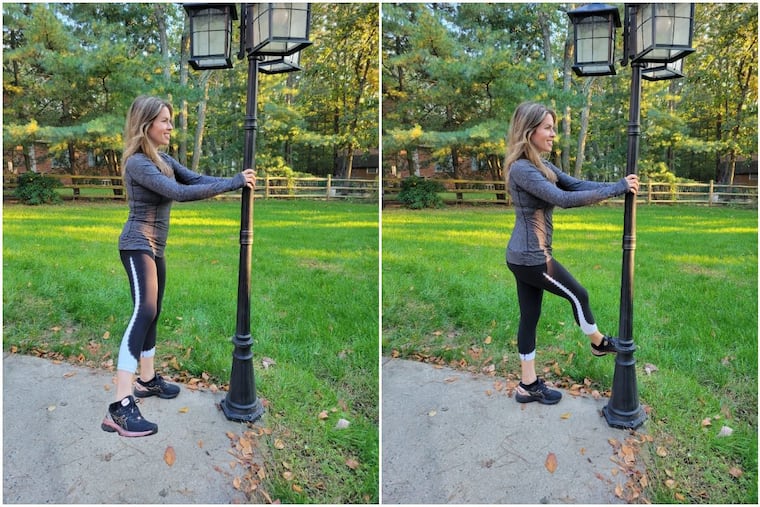Maximize your walking workout with these 3 tips from a race walking pro
Jeff Salvage, a former race walker and South Jersey coach, said the best way to improve your walking routine is to “learn to walk more athletically.”

Do you want to boost the intensity of your walking workout? Walking is an all-star aerobic exercise, providing a bevy of benefits such as a healthier heart, improved circulation, reduced blood pressure, better blood glucose control, and stress reduction. And it’s low-impact, which keeps sensitive joints healthy and happy.
So often, walking is dismissed as being an easier workout when compared with more pulse-pounding activities such as running or cycling. But increasing the speed of your step can hike your heart rate up to a zone similar to higher intensity exercises. Think: power walking. Faster feet will burn more calories, increase endurance, bolster bone density, and cut down on the longer time commitment associated with a slower-paced stroll.
Jeff Salvage, a former race walker, South Jersey coach and founder of racewalk.com, said the best way to improve your walking routine is to “learn to walk more athletically.”
“You get all of the benefits [of higher impact athletics], as well as an increased range of motion, without the pounding that comes with running,” he said.
If you’re unfamiliar with race walking, it’s an Olympic sport that shares the health advantages of running, but it requires the competitor to maintain contact with the ground at all times. (Power walking is a less technical style of walking that simply means to increase the rate at which you move.)
» READ MORE: 4 ways to improve your flexibility after pandemic inactivity
Salvage said learning the techniques competitive race walkers use can help you increase range of motion, strength, and cardiovascular health.
To safely put more pep in your step, Salvage shared these three suggestions:
Aim to be an athlete. To make your walk more athletic and “less pedestrian,” Salvage said to focus on increasing your range of motion at the shoulders by pumping your arms faster. This movement will amp up your heart rate, speed, and caloric expenditure. Another fun fact: Your arms dictate the speed of your walk. So if you pump your arms quickly, your legs will follow that pace to power up your step.
The hips are your hub. When walking, it’s common to shift the hips in a side-to-side motion. But Salvage said a better way to increase the power of your stride, is to “drive from the hips by moving forward and backward, not side-to-side.” Nailing this new form takes effort and time. You will need to have patience trying to retrain and rewire your muscle memory. Working with a coach is ideal for achieving this new walking style. Like anything, it takes practice.
Don’t skip stretching. Whether you’re strapped for time, or simply forget to add flexibility training to your routine, stretching is one fitness factor that’s often skipped. But in order to stay loose and limber, as well as avoid injuries, a proper warm-up and cool-down are key.
To warm up, Salvage suggests ditching static stretches. (Think: holding your leg in a hamstring stretch.) Those are best suited for your post-workout cool down. Instead, try dynamic drills that mimic your movement patterns and engage the muscles that will be working while walking.
» READ MORE: Why weight training is important for men and women
Here are some dynamic stretches to help strengthen your strut:
Reverse lunge
Begin by standing tall with feet shoulder-width apart. Take a step back with your right foot and lower into a lunge, keeping your right leg straight. Both feet should be forward-facing.
Hold for 10 counts, then push through your front left heel to stand and bring your feet together. Repeat on the opposite side. Continue this sequence for 10 strides (five per side).
Stork pose
Stand near a wall for support. Carefully pull your right leg up, wrapping your hands around the front of your knee and bringing it in toward your chest. Avoid locking your supporting leg. Hold for two counts, then release. Repeat on the left side. Continue walking forward, holding one knee at a time for eight counts.
Straight-leg lateral swing
Stand in front of a sturdy wall with both hands resting on it at shoulder height.
In a controlled manner, swing your right leg out laterally. This should feel natural and smooth, and remain within your range of motion. Keep your toes forward-facing.
As you bring your leg back in, let it cross in front of your left leg. Swing your right leg back and forth like a pendulum for 10 reps then practice on the other leg.
Ashley Blake Greenblatt is a certified personal trainer and wellness coach in South Jersey. Learn more about her virtual training program at ashleyblakefitness.com.